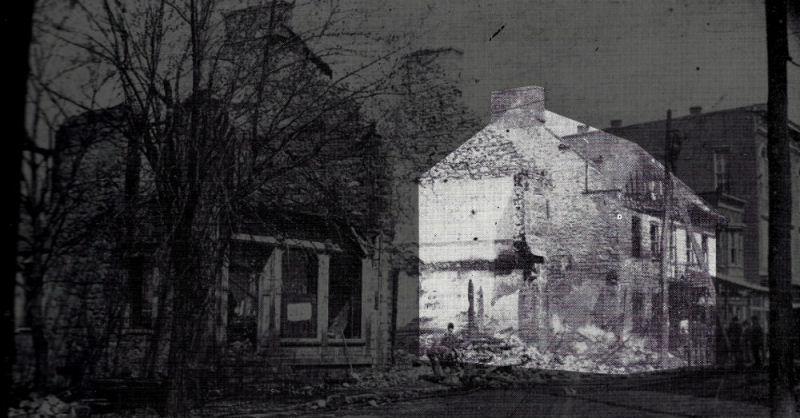
The Bouquet House
A large, five-bay two-story stone structure was built to the west of Fort Bedford along the north side of Forbes Road by Christopher Lems. It was built contempory with the construction of the fort. Christopher Lems appears as a fascinating and elusive figure in the history of Bedford County due to a number of unusual ‘facts’ presented about him by past historians.
In the first place, the surname, Lems, is often substituted with the name Lewis, but never with any explanation. It has also appeared as Lims and Limes. It is possible that some early historians might have misread old handwriting, interpreting the ‘m’ of Lems as ‘wi’, thereby changing Lems to Lewis. Such an error could easily lead to the variations of Lims and Limes.
The second point regards Christopher Lems’ military status. When the name, Christopher Lems appears in a history book, it is usually prefaced by the military rank of Captain. According to certain historians, Henry Bouquet was known to stay at Captain Christopher Lems’ large stone dwelling house, possibly during his time overseeing Fort Bedford, and also when he visited the region following the completion of the Forbes Expedition ~ leading to the house becoming known as ‘Bouquet’s House.’ How Bouquet and Lems had become associated in the first place is not known. Lems might have served in the ranks of the provincial troops in Forbes’ army under Bouquet, but his name does not appear in any of the available rosters. Bedford County historian, Charles N. Hickok, submitted an article to the editors of the newspaper, Republican and Inquirer shortly after the so-called King’s House was destroyed by fire in 1901. In that article he noted that “The oldest house now in Bedford, since the burning of the ‘King’s House,’ is the Boquet house… It was built by Capt. Lems, one of the earliest commandants at the fort…” Christopher Lems is not noted anywhere else as having served as the commandant of Fort Bedford, and Mr. Hickok did not note the source of his information. The author of Chapter Four of the Souvenir Historical Program – Fort Bedford Bicentennial, edited by Hugo K. Frear, stated that “Capt. Lewis sometimes presided at the Fort in the absence of Col. Bouquet.” Produced in the year 1958 for the Fort Bedford bicentennial, and lacking any reference to its source, the statement was probably based on Hickok’s information.
The name of Christopher Lems appears a couple times in Colonel Henry Bouquet’s papers. In regard to the transport of oats between Forts Ligonier and Bedford, in August 1761, a man simply noted as ‘Limes’ is suggested to Henry Bouquet by Lieutenant Archibald Blane. Another instance of the name in Bouquet’s papers was in a letter dated 14 December 1760 which Lieutenant Ourry wrote from Philadelphia to Henry Bouquet, commanding at Fort Pitt. He noted that the letter was being delivered to Bouquet by “Lems the Suttler, who has applied to me for leave to build a Tavern near Turtle Creek, but I have refer’d him to you…” If Christopher Lems had been filling in as commandant of Fort Bedford in Henry Bouquet’s absence, there surely would have been no need for Lieutenant Lewis Ourry to introduce him to Bouquet in December 1760. The letter continued with “he keeps one [tavern] at Bedford where he has always behaved very well.” From the statements in this letter, it would seem appropriate to assume that Christopher Lems was not in the army prior to December 1760, but rather made a living as a suttler and tavern keeper.
At one point, the Bouquet House was fortified. According to an article published in the Bedford Gazette in 1906: since the original Fort Bedford had fallen into ruins by 1771, George Woods, having purchased the stone dwelling of Christopher Lems (known as the Bouquet House), constructed a ‘picket fort’ around it. When the alarm of an attack by Amerindians was sounded, the people in the town would take refuge in the large stone structure, it then being called ‘Fort Bedford.’
The large stone house that Christopher Lems built, and at which Colonel Henry Bouquet stayed when he returned to the region was not photographed before its destruction in 1901. The image below is a photograph of the north side of Pitt Street a day after the fire that was known as the Hartley Bank Fire. Despite the loss of the building's roof, the gable wall and the facade were still standing when the photo was taken. The assumed structure of the Bouquet House is highlighted.





